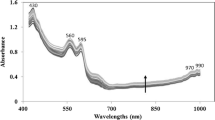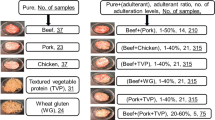Abstract
Hyperspectral imaging (HSI) was investigated to detect and visualize beef adulteration with duck meat. Minced beef was adulterated with duck meat in range of 0–100% (w/w) at 10% increments. Visible and near-infrared (VNIR) hyperspectral images were acquired, and extracted spectra were analyzed with preprocessing methods. Partial least squares regression (PLSR) and principal component regression (PCR) modeling methods were individually utilized, and the PLSR model based on full raw spectra performed best. To make the preferred model practical, optimal wavelengths were individually selected using two-dimensional correlation spectroscopy (2D-COS) and PC loadings. The model based on competent wavelengths selected from PC loadings resulted in good performance of Rp2 = 0.96, RMSEP = 6.58%, and RPD = 4.86 with limit of detection (LOD) of 7.59%. Finally, spatially distributed visualization was achieved using the simplified model, and adulteration levels were readily discernible. Known distributed samples were also successfully visualized, and the validity of visualization was thus proved. Results demonstrated the potential of the HSI to detect minced beef adulteration with duck meat.






Similar content being viewed by others
References
Abdulmawjood A, Grabowski N, Fohler S, Kittler S, Nagengast H, Klein G (2014) Development of loop-mediated isothermal amplification (lamp) assay for rapid and sensitive identification of ostrich meat. Plos One 9:e100717
Alamprese C, Casale M, Sinelli N, Lanteri S, Casiraghi E (2013) Detection of minced beef adulteration with turkey meat by UV–Vis, NIR and MIR spectroscopy. LWT-Food Sci Technol 53:225–232
Andrés S, Murray I, Navajas EA, Fisher AV, Lambe NR, Bünger L (2007) Prediction of sensory characteristics of lamb meat samples by near infrared reflectance spectroscopy. Meat Sci 76:509–516
Ballin NZ (2010) Authentication of meat and meat products. Meat Sci 86:577–587
Barbin D, ElMasry G, Sun DW, Allen P (2012) Near-infrared hyperspectral imaging for grading and classification of pork. Meat Sci 90:259–268
Barbin DF, ElMasry G, Sun DW, Allen P (2013) Non-destructive determination of chemical composition in intact and minced pork using near-infrared hyperspectral imaging. Food Chem 138:1162–1171
Bilge G, Velioglu HM, Sezer B, Eseller KE, Boyaci IH (2016) Identification of meat species by using laser-induced breakdown spectroscopy. Meat Sci 119:118–122
Bowker B, Hawkins S, Zhuang H (2014) Measurement of water-holding capacity in raw and freeze-dried broiler breast meat with visible and near-infrared spectroscopy. Poult Sci 93:1834–1841
Chou CC, Lin SP, Lee KM, Hsu CT, Vickroy TW, Zen JM (2007) Fast differentiation of meats from fifteen animal species by liquid chromatography with electrochemical detection using copper nanoparticle plated electrodes. J Chromatogr B Analyt Technol Biomed Life Sci 846:230–239
Chu X, Wang W, Ni X, Zheng H, Zhao X, Zhang R, Li Y (2018) Growth Identification of Aspergillus flavus and Aspergillus parasiticus by visible/near-infrared hyperspectral imaging. Appli Sci 8:513
ElMasry G, Sun DW, Allen P (2011) Non-destructive determination of water-holding capacity in fresh beef by using NIR hyperspectral imaging. Food Res Int 44:2624–2633
ElMasry G, Sun DW, Allen P (2013) Chemical-free assessment and mapping of major constituents in beef using hyperspectral imaging. J Food Eng 117:235–246
He H, Hong X, Feng Y, Wang Y, Ying J, Liu Q, Qin Y, Zhou X, Wang D (2015) Application of quadruple multiplex PCR detection for beef, duck, mutton and pork in mixed meat. J Food Nutr Res 3:392–398
Jiang H, Zhuang H, Sohn M, Wang W (2017) Measurement of soy contents in ground beef using near-infrared spectroscopy. Appli Sci 7:97
Jiang H, Wang W, Zhuang H, Yoon SC, Li Y, Yang Y (2018a) Visible and near-infrared hyperspectral imaging for cooking loss classification of fresh broiler breast fillets. Appli Sci 8:256
Jiang H, Yoon SC, Zhuang H, Wang W, Lawrence KC, Yang Y (2018b) Tenderness classification of fresh broiler breast fillets using visible and near-infrared hyperspectral imaging. Meat Sci 139:82–90
Kamruzzaman M, ElMasry G, Sun DW, Allen P (2013a) Non-destructive assessment of instrumental and sensory tenderness of lamb meat using NIR hyperspectral imaging. Food Chem 141:389–396
Kamruzzaman M, Sun DW, Elmasry G, Allen P (2013b) Fast detection and visualization of minced lamb meat adulteration using NIR hyperspectral imaging and multivariate image analysis. Talanta 103:130–136
Kamruzzaman M, Makino Y, Oshita S, Liu S (2015a) Assessment of visible near-infrared hyperspectral imaging as a tool for detection of horsemeat adulteration in minced beef. Food Bioprocess Technol 8:1054–1062
Kamruzzaman M, Makino Y, Oshita S (2015b) Hyperspectral imaging in tandem with multivariate analysis and image processing for non-invasive detection and visualization of pork adulteration in minced beef. Anal Methods 7:7496–7502
Kamruzzaman M, Makino Y, Oshita S (2016) Rapid and non-destructive detection of chicken adulteration in minced beef using visible near-infrared hyperspectral imaging and machine learning. J Food Eng 170:8–15
Kapper C, Klont RE, Verdonk JMAJ, Urlings HAP (2012) Prediction of pork quality with near infrared spectroscopy (NIRS): 1. Feasibility and robustness of NIRS measurements at laboratory scale. Meat Sci 91:294–299
Keithley RB, Wightman RM, Heien ML (2009) Multivariate concentration determination using principal component regression with residual analysis. TrAC Trends Anal Chem 28:1127–1136
Liu Y, Chen YR (2000) Two-dimensional correlation spectroscopy study of visible and near-infrared spectral variations of chicken meats in cold storage. Appl Spectrosc 54:1458–1470
Liu D, Zeng XA, Sun DW (2013) NIR spectroscopy and imaging techniques for evaluation of fish quality—a review. Appl Spectrosc Rev 48:609–628
Macedo-Silva A, Barbosa SFC, Alkmin MGA, Vaz AJ, Shimokomaki M, Tenuta-Filho A (2000) Hamburger meat identification by dot-ELISA. Meat Sci 56:189–192
Mahesh S, Jayas DS, Paliwal J, White NDG (2015) Comparison of partial least squares regression (PLSR) and principal components regression (PCR) methods for protein and hardness predictions using the near-infrared (NIR) hyperspectral images of bulk samples of Canadian wheat. Food Bioprocess Technol 8:31–40
Menesatti P, Zanella A, D’Andrea S, Costa C, Paglia G, Pallottino F (2009) Supervised multivariate analysis of hyper-spectral NIR images to evaluate the starch index of apples. Food Bioprocess Technol 2:308–314
Noda I (1993) Generalized two-dimensional correlation method applicable to infrared, Raman, and other types of spectroscopy. Appl Spectrosc 47:1329–1336
Premanandh J (2013) Horse meat scandal–A wake-up call for regulatory authorities. Food Control 34:568–569
Qin J, Burks TF, Kim MS, Chao K, Ritenour MA (2008) Citrus canker detection using hyperspectral reflectance imaging and PCA-based image classification method. Sens Instrum Food Qual Saf 2:168–177
Rahmati S, Julkapli NM, Yehye WA, Basirun WJ (2016) Identification of meat origin in food products–a review. Food Control 68:379–390
Ropodi AI, Pavlidis DE, Mohareb F, Panagou EZ, Nychas GJ (2015) Multispectral image analysis approach to detect adulteration of beef and pork in raw meats. Food Res Int 67:12–18
Ropodi AI, Panagou EZ, Nychas GJE (2017) Multispectral imaging (MSI): a promising method for the detection of minced beef adulteration with horsemeat. Food Control 73:57–63
Tang Z, Zhou Y, Zhou Y, Zheng P (2015) Brief analysis on harm and sensory identification of five kinds of questionable meat. Meat Ind 416:47–54 (in Chinese)
Wu D, Sun DW (2013) Application of visible and near infrared hyperspectral imaging for non-invasively measuring distribution of water-holding capacity in salmon flesh. Talanta 116:266–276
Wu D, Shi H, He Y, Yu X, Bao Y (2013) Potential of hyperspectral imaging and multivariate analysis for rapid and non-invasive detection of gelatin adulteration in prawn. J Food Eng 119:680–686
You Z, Zhuo L, Yang X, Hong H, Liu Z, Gong Z, Cheng F (2015) Food research applications of two-dimensional correlation spectroscopy. Appl Spectrosc Rev 50:840–858
Zhong K, Han F, Yao K, Ren X, Chen S, Luo X, Guo L (2012) Current situation, problems, challenges and counter measures of food safety risk communication in China. Chin J Food Hyg 24:578–586 (in Chinese)
Funding
This work was supported by the National Natural Science Foundation of China (Grant NO. 31772062).
Author information
Authors and Affiliations
Corresponding author
Ethics declarations
Conflict of Interest
Hongzhe Jiang declares that he has no conflict of interest. Wei Wang declares that he has no conflict of interest. Hong Zhuang declares that he has no conflict of interest. Seung-Chul Yoon declares that he has no conflict of interest. Yi Yang declares that he has no conflict of interest. Xin Zhao declares that she has no conflict of interest.
Ethical Approval
This article does not contain any studies with human participants or animals performed by any of the authors.
Informed Consent
Not applicable.
Additional information
Publisher’s Note
Springer Nature remains neutral with regard to jurisdictional claims in published maps and institutional affiliations.
Rights and permissions
About this article
Cite this article
Jiang, H., Wang, W., Zhuang, H. et al. Hyperspectral imaging for a rapid detection and visualization of duck meat adulteration in beef. Food Anal. Methods 12, 2205–2215 (2019). https://doi.org/10.1007/s12161-019-01577-6
Received:
Accepted:
Published:
Issue Date:
DOI: https://doi.org/10.1007/s12161-019-01577-6




